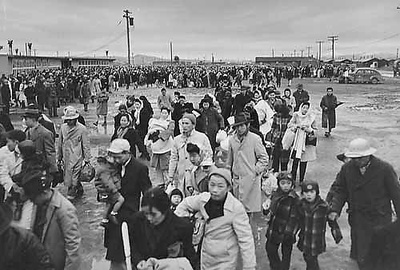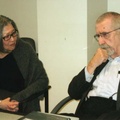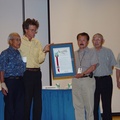“How was the pilgrimage?”
It’s a question I and other pilgrims have been asked many times since returning from the 2009 Tule Lake Pilgrimage that took place over the 4th of July weekend.
As one of the event organizers, it’s a question I have trouble answering in a sentence or two.
It was the biggest pilgrimage that our small, all-volunteer committee has organized. It was also remarkable that of the 400 pilgrims, 56 of them were 80 years of age or older; and of that group, 50 had been incarcerated in Tule Lake.
Once at Tule Lake, we had the pilgrims on a demanding schedule—celebrating Tule Lake’s new National Monument status, hiking Castle Rock, honoring our forebears, hearing stories about Tule Lake and the no-nos, seeing remains of the campsite, addressing the painful emotional legacy of the wartime incarceration, and multiple workshops—with accommodations that featured thin mattresses and coarse linens, and long, long lines to eat meals and to use the public toilets and porta-potties.
Despite the discomfort, crowding, and heat, we heard no monku about the inconvenience, the waiting, or the delays. The pilgrims were patient and considerate of one another, encouraging the older folks to go to the front of the lines to make the long trip easier for them. Rather than the expected barrage of complaints (I remember Ron Wakabayashi describing the art of monku as a deadly Nisei martial art), we received “thanks” and words of appreciation. It was really quite phenomenal.
The core, the most important part of the pilgrimage, was honoring the “no-nos” who were segregated at Tule Lake, for their courage in protesting the unjust wartime incarceration.
For more than 65 years, the stories of the 12,000 “no-nos” have been hidden away and misunderstood (usually confused with the 315 men who resisted the 1944 draft on Constitutional grounds and served time in Federal prisons). The “no-nos” were the ones who, in early 1943, protested their incarceration and loss of freedom, using, as their vehicle of protest, the deeply-flawed loyalty questions, #27 concerning military service, and #28, a disavowal of assumed loyalty to the Japanese Emperor. Yet, instead of celebrating their refusal to cooperate with the government’s demand to answer these questions, our community has labeled them as “disloyal,” as “troublemakers” and “bad apples,” and treated them with derision and scorn – the “dirty linen” to be hidden away.
It’s akin to African-Americans referring to civil rights movement heroes like Rosa Parks, Medgar Evers, or Fannie Lou Hamer as “troublemakers” and “agitators” because they protested injustice. Imagine the African-American community adopting the views of the White Southern bigots and segregationists, instead of supporting racial equality.
The myth of a super-patriotic Japanese American community was promoted, 200% Americans who didn’t protest and who shed blood to prove loyalty. It was a post-war image that was used to help White America view Japanese Americans in a positive light—a reversal of the Tojo-loving, subversive buck-tooth “Jap” propaganda that helped foster the incarceration.
Of course, these positive stereotypes existed to manipulate public opinion as much as the negative ones. The “model minority” image helped defuse hostile attitudes, making it easier for Japanese Americans struggling to get jobs and housing after the war.
The “loyal” stereotype, however, demonized civil rights protesters as pro-Japan fanatics and Emperor worshipers. Perversely, as a result, many Japanese Americans have internalized the racism of the War Relocation Authority and the Western Defense Command, and learned to stigmatize protest in the American tradition, viewing it as disloyalty and support of enemy Japan.
The stories of the 12,000 protesters who were segregated at Tule Lake have gone untold for the past 67 years because of this stigma. They learned their protests at Tule Lake were viewed as disloyalty and something that should be hidden away; consequently, most have not talked about their dissent.
We wanted to make sure that we don't lose their stories forever, which is why the Tule Lake Committee organized this off-year pilgrimage to Tule Lake. We hope to motivate those who care about civil rights to do what they can to fill those missing pages, to honor the courage of our unsung civil rights activists, and to welcome these heroes back into the community.
We hope that others will feel and do the same.

Internees leaving for Japan after the war, gather at the Tule Lake social hall. November 1945.Gift of Jack and Peggy Iwata, Japanese American National Museum (93.102.8)
© 2009 Barbara Takei





